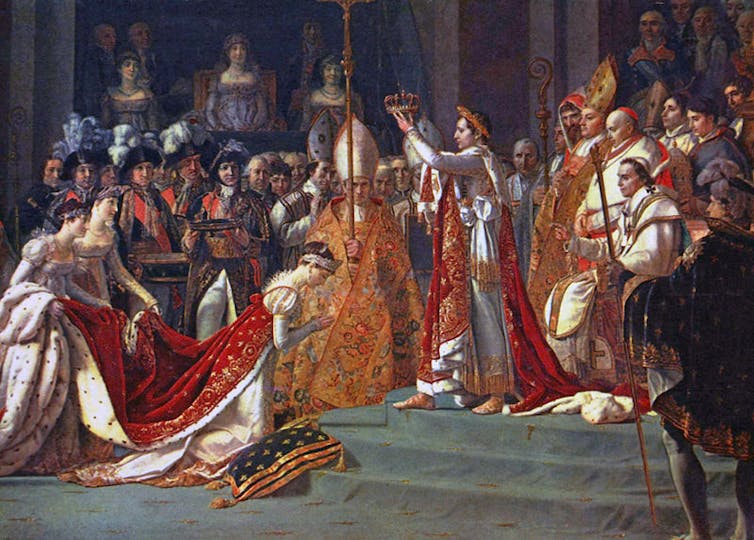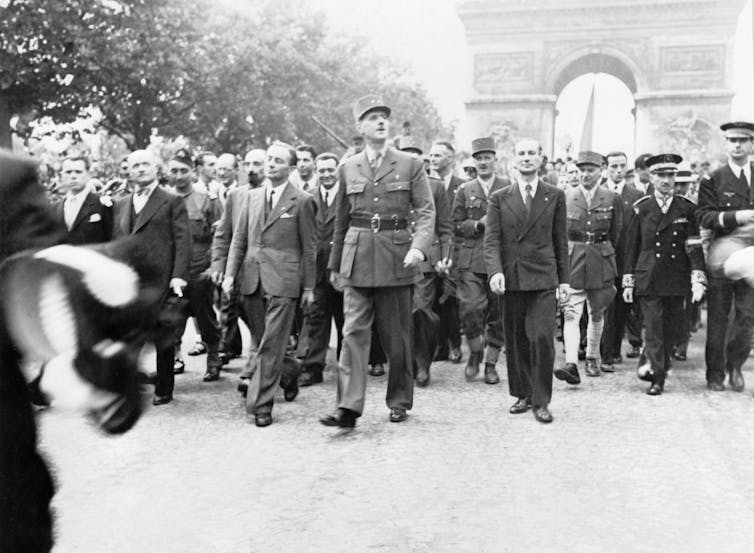While flames engulfed Notre Dame on the evening of April 15 and the world watched in despair, French president Emmanuel Macron told news cameras that the Paris cathedral was part of the history of all French people:
It is our history, our literature, our imagination, the place where we have lived our great moments … it is the epicentre of our life.
Macron hit the mark in more ways than one. Certainly, since its first stone was laid in 1163, Notre Dame has witnessed a great many of France’s iconic moments. It was, after all, the church of the country’s medieval kings long before the royal court moved out to Versailles in the 17th century.
In 1558, it witnessed the marriage of Mary Queen of Scots to the Dauphin, soon to be King François II. In 1804, Napoleon Bonaparte crowned himself emperor there. And, on August 26 1944, the towering frame of general Charles de Gaulle strode triumphantly down the aisle for a thanksgiving service on the liberation of Paris from Nazi occupation – having braved snipers on the way.

Napoleon Bonaparte crowning himself emperor in Notre Dame, December 1804. Jacques-Louis David and Georges Rouget
Notre Dame is one of the country’s “lieux de mémoire”, a “realm of memory”, to use historian Pierre Nora’s term; a place where historical memory is embedded and commemorated.
Secret lives
All buildings have their “secret lives” – a topic that Edward Hollis explores in his brilliant book with that very title. One of the cathedral’s secret lives was its part in the “culture war” that bitterly divided France after the Revolution of 1789. The Revolution was not only a frontal assault on hereditary privilege, seigneurialism and the monarchy – it also developed into an attack on the Catholic church, and Notre Dame was one of the most important sites of this conflict.
In the autumn of 1793, as the Terror gathered pace, the firebrands who dominated Paris’ municipal government ordered the removal of the statues that lined Notre Dame’s façade above its great doors.
These, it was proclaimed, were “the gothic simulacra of the Kings of France” (in fact, they represented the Kings of Judea). As the iconoclasm swept through the city, the interior of the cathedral was gutted: all religious images, statues, effigies, reliquaries and symbols were stripped out until all that remained was a bare shell of masonry and timber. The cathedral’s bells and spire were melted down for their metal.
This was the most serious damage sustained by the cathedral in modern times, until the recent fire, and yet (and here we might take heart) Notre Dame would be restored in the 19th century by Eugène-Emmanuel Viollet-le-Duc, whose work included the replacement spire that fell so tragically in flames on April 15.
The crescendo of the revolutionary campaign of “dechristianisation” came on November 10, 1793 when Notre Dame – renamed the “Temple of Reason” – played host to a secular, atheist festival to the triumph of human reason over religion and superstition. The French Revolution left a legacy of cultural and political division between, on the one hand, the Republic, the secular and visions of a democratic, rights-based order, and, on the other hand, the Church, the sacred and memories of the old monarchy.
Crisis of faith
Napoleon Bonaparte papered over the chasm in 1801 by signing a Concordat – an agreement with the Pope, whereby he pragmatically recognised Catholicism as the religion of the “great majority of French citizens”. This was a clever formula that was both a statement of fact and left room for other faiths. In return, the Pope accepted many of the reforms of the Revolution and Notre Dame was returned to the Church in April 1802.
Despite this compromise, friction continued between the church and the state as the political pendulum swung back and forth over the course of the 19th century. Education was a particularly contentious battleground, as both sides fought to win the hearts and minds of the younger generations.
From this conflict sprang the republican principle of “laïcité”. While French people of all races and creeds were free to practice their beliefs as private individuals, in their contacts with the state, particularly in schools, they were meant to be equal citizens abiding by the same laws and adhering to the same, universal, republican values.
Notre-Dame was given a role in this – if only in opposition to laïcité. When the Eiffel Tower was opened in 1889 for the Universal Exposition, itself commemorating the centenary of the French Revolution, it was heralded by republicans as a triumph of human reason, science and progress over faith and superstition.
The French diplomat and travel-writer Eugène Melchior de Vogüé imagined an argument between Notre Dame and the Eiffel Tower, between the old and the new, between faith and science. The cathedral’s two towers mock Eiffel’s creation:
You are ugly and empty; we are beautiful and replete with God … Fantasy for a day, you will not last, because you have no soul.
The iron structure retorts:
Old abandoned towers, no one listens to you anymore … You were ignorance; I am knowledge. You keep man enslaved; I free him … I have no more need of your God, invented to explain a creation whose laws I know.
In 1905, the republicans finally triumphed, formally separating church and state, thereby tearing up Napoleon’s Concordat. Notre Dame itself, along with other ecclesiastical property, was taken over by the government.
Sacred union
So Notre Dame is certainly a symbol of France’s past, but not only because of its longevity, its royal associations, its undeniably stunning architecture and its location on the Île de la Cité – the ancient legal, political and ecclesiastical heart of the former kingdom. It also stood as a site – and a symbol – of the culture war: the “Franco-French” conflict between, on the one hand, the country’s monarchist and Catholic traditions and, on the other hand, its revolutionary and republican heritage. These frictions have periodically torn the country apart since 1789. This is its hidden history.
This alone is reason to mourn the damage, because its “secret life” carries lessons for all of us – about the relationship between church and state, faith and reason, the secular and the sacred, about tolerance and intolerance, about the use and abuse of religion and culture.
But happily this is not the full story. In times of national crisis, the French have shown an inspiring capacity to rally together, evoking the “union sacrée”, the unity of wartime in 1914, just as they mobilised around the democratic, republican values in response to the terrorist attacks in 2015.
And Notre Dame has historically played a part in these moments of reconciliation and union. When France emerged from the brutal, sectarian 16th-century strife between Catholics and the Protestant Huguenots – remembered as the Wars of Religion – the Protestant Henri de Navarre, who took the crown as Henri IV, pragmatically decided that: “Paris is well worth a Mass” and converted to Catholicism.
When he rode into the capital in 1594, he immediately took communion in Notre Dame: it was a moment that promised peace between Catholics and Protestants (and four years later, the new king issued the Edict of Nantes, which declared toleration for both faiths).
It was in Notre Dame, too, that the official celebrations of Napoleon’s compromise with the Church, the Concordat, came to a climax on Easter Sunday 1802, with a Mass attended by the entire government of a republic once deemed “Godless”.
In 1944, de Gaulle’s triumphant march to Notre Dame through liberated Paris was a moment of catharsis for French people humiliated by four years of Nazi occupation. And in 1996, the then president Jacques Chirac (also the first French president to make a state visit to the Vatican) helped to arrange a Requiem Mass for his agnostic predecessor, François Mitterand.

General Charles de Gaulle marches down the Champs Elysees to Notre Dame for a service of thanksgiving following the city’s liberation in August 1944. Imperial War Museum, CC BY
The gesture – and the subsequent papal visit that same year – certainly elicited protests from people, particularly on the left, who defended a pure form of laïcité. Yet that Chirac, who in other contexts steadfastly defended the Republic’s secularism, could as president do these things suggests how far the boundaries between republicanism and Catholicism have softened. Notre Dame is certainly an appropriate site to reflect on this because it is both state property – and officially designated a “monument historique” as long ago as 1862 – and a fully-functioning church.
Bridges to build
This is not to say that there are no bridges still to build, or frictions to resolve – far from it. Recently, controversies over laïcité have revolved around attempts to ban the hijab, the burka and the burkini, which have stoked fears of racism and of the exclusion of France’s substantial Muslim population. And while there is certainly a dark side to les gilet jaunes, they are no less a symptom of deep economic distress and social malaise.
So when Macron, on first learning of the terrible fire consuming Notre Dame, could tweet that his thoughts were with “all Catholics and for all French people” and that “tonight I am sad to see this part of us burn”, he was – perhaps intentionally – almost using the Napoleonic language of the Concordat. His tweet recognised that not all French people are Catholic, while at the same time stating that the iconic cathedral is the heritage of all citizens regardless of belief.
And indeed the rector of the Paris Grand Mosque, Dalil Boubakeur, issued a press release as the fire still blazed, saying: “We pray that God might safeguard this monument so precious to our hearts.”
When the reconstruction of Notre Dame begins, the country will be restoring not only a site of its history, but also a symbol of the complexities of that history, complexities that, hopefully, remind us of a capacity for healing, inclusion and unity.



 If you squat in a vacant property, does the law give you the house for free? Well, sort of
If you squat in a vacant property, does the law give you the house for free? Well, sort of  Mexico’s slow slide towards vigilante violence
Mexico’s slow slide towards vigilante violence  Gaza war: Israel using AI to identify human targets raising fears that innocents are being caught in the net
Gaza war: Israel using AI to identify human targets raising fears that innocents are being caught in the net  EU enlargement: What does the future hold?
EU enlargement: What does the future hold?  In a time of information overload, enigmatic philosopher Byung-Chul Han seeks the re-enchantment of the world
In a time of information overload, enigmatic philosopher Byung-Chul Han seeks the re-enchantment of the world  Why doesn’t my digital music feel like ‘mine’? Three ways digital possessions reduce our sense of ownership
Why doesn’t my digital music feel like ‘mine’? Three ways digital possessions reduce our sense of ownership  The big dry: forests and shrublands are dying in parched Western Australia
The big dry: forests and shrublands are dying in parched Western Australia  Why are blooper reels so funny?
Why are blooper reels so funny?  Video games at work? It sounds fun, but there are ethical risks
Video games at work? It sounds fun, but there are ethical risks  The yen plunges to 34-year low despite interest rate hike
The yen plunges to 34-year low despite interest rate hike  Is attachment theory actually important for romantic relationships?
Is attachment theory actually important for romantic relationships? 






























